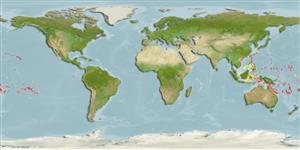分類 / Names
俗名 | 同種異名 | Catalog of Fishes(屬, 種) | ITIS | CoL | WoRMS | Cloffa
Teleostei >
Gobiiformes (Gobies)
鱸形目 (Gobies) >
Gobiidae (Gobies)
鰕虎魚科 (Gobies) > Gobiinae
Etymology: Eviota: No etymology given, suggested by Christopher Scharpt: from Latin 'eu' for 'true' and 'iota' for anything very small, in combination 'truly very small' referring to it as being the smallest vertebrate at the time it has benn described by Jenkins (thus, making the suggestion by Scharpt plausible.; randalli: Named for John E. Randall; patronym in genitive case..
More on author: Greenfield.
Environment: milieu / climate zone / depth range / distribution range
生態學
海洋 礁區魚類; 深度上下限 3 - 17 m (Ref. 83326).
Pacific: Fiji, Tahiti and Samoa Islands; Palau specimens .incertae sedis.
大小 / 重量 / 年齡
Maturity: Lm ? range ? - ? cm
Max length : 1.8 cm SL 雄魚/尚未辨別雌雄; (Ref. 83326); 1.7 cm SL (female)
簡短描述
檢索表 | 型態特徵 | 形態測量圖
背棘 (總數) : 7; 背的軟條 (總數) : 8; 臀棘: 1; 臀鰭軟條: 8. This species is distinct in having the following characters: D VI+I,8, A I,8; pectoral-fin rays branched, only starting with ray 10 (usually 11 or 12); cephalic sensory-pore system pattern I (complete); absence of fifth segmented pelvic-fin ray; 3-4 branches on fourth pelvic-fin ray, 3-7 segments between branches (usually 3-4); non-fimbriated genital papilla; slightly filamentous dorsal fin; 3 internal dark bars between anal-fin origin and caudal fin; lower half of pectoral-fin base with a distinct dark spot and anterior to the base is a white area (Ref. 83326). Dorsal to anal fin-ray formula 8/8.
Life cycle and mating behavior
Maturities | 繁殖 | Spawnings | Egg(s) | Fecundities | 仔魚
Greenfield, D.W., 2009. Eviota randalli, a new gobiid fish from Oceania. Proc. Calif. Acad. Sci. 60(20):683-687. (Ref. 83326)
人類使用
工具
特別的報告
下載 XML
網路資源
Estimates based on models
Preferred temperature (Ref.
123201): 25 - 29.4, mean 28 °C (based on 1120 cells).
Phylogenetic diversity index (Ref.
82804): PD
50 = 0.5000 [Uniqueness, from 0.5 = low to 2.0 = high].
Bayesian length-weight: a=0.01023 (0.00477 - 0.02194), b=3.02 (2.84 - 3.20), in cm total length, based on LWR estimates for this (Sub)family-body shape (Ref.
93245).
營養階層 (Ref.
69278): 3.0 ±0.3 se; based on size and trophs of closest relatives
Fishing Vulnerability (Ref.
59153): Low vulnerability (10 of 100).
